Study on Thermal Radiation Characteristics and the Multi-Point Source Model of Hydrogen Jet Fire
Abstract
:1. Introduction
2. Experimental Setup
3. Theoretical Basis of Numerical Simulation
3.1. Control Equations
- The component conservation equation is:
- 2.
- Continuity equation
- 3.
- Momentum conservation equation
- 4.
- Energy conservation equation
3.2. Turbulence Model
3.3. Combustion Model
3.4. Radiation Model
3.5. Computational Domain and Boundary Conditions
3.6. Grid Independence Verification
3.7. Optimization of Thermal Radiation Prediction Model
4. Results and Discussion
4.1. Model Validation
4.2. Flame Size
4.3. Thermal Radiation
4.4. Numerical Simulation
4.4.1. Effect of Leakage Pressure
4.4.2. Effect of Leakage Diameter
4.5. Optimization of Thermal Radiation Prediction Model
5. Conclusions
- The study of the hydrogen jet flame dimensions indicated that both the flame length and width increase with higher leakage pressures and diameters. The flame length prediction model based on the Froude number is particularly suitable for medium–high-pressure hydrogen jet fires. The flame shapes under different leakage pressures and diameters exhibited a certain degree of similarity, with the ratio coefficient of the flame length to width being 5.819.
- The thermal radiation density significantly decreased with increasing radial distance and height. The thermal radiation at various spatial positions was influenced by flame oscillations and showed an approximately linear increase with a rising leakage pressure and diameter. Additionally, increased leakage pressures and diameters elevated the flame height corresponding to the maximum thermal radiation.
- Optimizing the heat source weight coefficients based on the flame axis temperature distribution significantly reduced the prediction error of the multi-point source radiation model by 5.6%. In six comparative scenarios, the average prediction error of the optimized model was 13.9%, compared with 19.5% for the original model, demonstrating a higher predictive accuracy.
Author Contributions
Funding
Data Availability Statement
Conflicts of Interest
References
- Sadeq, A.M.; Homod, R.Z.; Hussein, A.K.; Togun, H.; Mahmoodi, A.; Isleem, H.F.; Patil, A.R.; Moghaddam, A.H. Hydrogen energy systems: Technologies, trends, and future prospects. Sci. Total Environ. 2024, 939, 173622. [Google Scholar] [CrossRef] [PubMed]
- Sikiru, S.; Oladosu, T.L.; Amosa, T.I.; Olutoki, J.O.; Ansari, M.N.M.; Abioye, K.J.; Rehman, Z.U.; Soleimani, H. Hydrogen-powered horizons: Transformative technologies in clean energy generation, distribution, and storage for sustainable innovation. Int. J. Hydrogen Energy 2024, 56, 1152–1182. [Google Scholar] [CrossRef]
- Kummer, J.-R.; Essmann, S.; Markus, D.; Grosshans, H.; Maas, U. Assessing ignitions of explosive gas mixtures by low-energetic electrical discharges using OH-LIF and 1D-simulations. Combust. Sci. Technol. 2021, 195, 1–23. [Google Scholar] [CrossRef]
- Yang, R.; Schell, C.A.; Ruiz-Tagle, A.; Grabovetska, V.; Gupta, A.J.; Groth, K.M. Research gaps in quantitative risk assessment (QRA) of hydrogen transmission pipelines. Int. J. Hydrogen Energy 2024, 71, 916–929. [Google Scholar] [CrossRef]
- Weis, C.; Martin Sentko, M.; Stelzner, B.; Habisreuther, P.; Zarzalis, N.; Trimis, D. Experimental and numerical investigations of the laminar burning velocities of premixed fuel-rich methane oxy-fuel and oxygen-enhanced flames. Fuel 2024, 368, 131601. [Google Scholar] [CrossRef]
- Sun, B.; Zhao, H.; Dong, X.; Teng, C.; Zhang, A.; Kong, S.; Zhou, J.; Zhang, X.-C.; Tu, S.-T. Current challenges in the utilization of hydrogen energy-a focused review on the issue of hydrogen-induced damage and embrittlement. Adv. Appl. Energy 2024, 14, 100168. [Google Scholar] [CrossRef]
- Palacios, A.; Muñoz, M.; Darbra, R.M.; Casal, J. Thermal radiation from vertical jet fires. Fire Saf. J. 2012, 51, 93–101. [Google Scholar] [CrossRef]
- Ivanytskyi, Y.; Blikharskyy, Y.; Sęp, J.; Blikharskyy, Z.; Selejdak, J.; Holiian, O. Evaluation of the Technical Condition of Pipes during the Transportation of Hydrogen Mixtures According to the Energy Approach. Appl. Sci. 2024, 14, 5040. [Google Scholar] [CrossRef]
- Yang, N.; Deng, J.; Wang, C.; Bai, Z.; Qu, J. High pressure hydrogen leakage diffusion: Research progress. Int. J. Hydrogen Energy 2024, 50, 1029–1046. [Google Scholar] [CrossRef]
- Delichatsios, M.A. Transition from Momentum to Buoyancy-Controlled Turbulent Jet Diffusion Flames and Flame Height Relationships. Combust. Flame 1993, 92, 349–364. [Google Scholar] [CrossRef]
- Schefer, R.; Houf, W.; Bourne, B.; Colton, J. Spatial and radiative properties of an open-flame hydrogen plume. Int. J. Hydrogen Energy 2006, 31, 1332–1340. [Google Scholar] [CrossRef]
- Schefer, R.W.; Houf, W.G.; Williams, T.C.; Bourne, B.; Colton, J. Characterization of high-pressure, underexpanded hydrogen-jet flames. Int. J. Hydrogen Energy 2007, 32, 2081–2093. [Google Scholar] [CrossRef]
- Mogi, T.; Horiguchi, S. Experimental study on the hazards of high-pressure hydrogen jet diffusion flames. J. Loss Prev. Process Ind. 2009, 22, 45–51. [Google Scholar] [CrossRef]
- Molkov, V.; Saffers, J.-B. Hydrogen jet flames. Int. J. Hydrogen Energy 2013, 38, 8141–8158. [Google Scholar] [CrossRef]
- Liu, J.-Y.; Fan, Y.-Q.; Zhou, K.-B.; Jiang, J.-C. Prediction of Flame Length of Horizontal Hydrogen Jet Fire during High-pressure Leakage Process. Procedia Eng. 2018, 211, 471–478. [Google Scholar] [CrossRef]
- Gong, L.; Mo, T.; Han, Y.; Zheng, X.; Yang, S.; Yao, Y.; Zhang, Y. Experimental investigation on the behaviors and temperature distribution of cryogenic hydrogen jet flames. Int. J. Hydrogen Energy 2024, 50, 1062–1074. [Google Scholar] [CrossRef]
- Cirrone, D.; Makarov, D.; Kuznetsov, M.; Friedrich, A.; Molkov, V. Effect of heat transfer through the release pipe on simulations of cryogenic hydrogen jet fires and hazard distances. Int. J. Hydrogen Energy 2022, 47, 21596–21611. [Google Scholar] [CrossRef]
- Cirrone, D.M.C.; Makarov, D.; Molkov, V. Thermal radiation from cryogenic hydrogen jet fires. Int. J. Hydrogen Energy 2019, 44, 8874–8885. [Google Scholar] [CrossRef]
- Cirrone, D.M.C.; Makarov, D.; Molkov, V. Simulation of thermal hazards from hydrogen under-expanded jet fire. Int. J. Hydrogen Energy 2019, 44, 8886–8892. [Google Scholar] [CrossRef]
- Proust, C.; Jamois, D.; Studer, E. High pressure hydrogen fires. Int. J. Hydrogen Energy 2011, 36, 2367–2373. [Google Scholar] [CrossRef]
- Choi, S.Y.; Oh, C.B.; Do, K.H.; Choi, B.-I. A Computational Study of Hydrogen Dispersion and Explosion after Large-Scale Leakage of Liquid Hydrogen. Appl. Sci. 2023, 13, 12838. [Google Scholar] [CrossRef]
- Mashhadimoslem, H.; Ghaemi, A.; Palacios, A.; Hossein Behroozi, A. A new method for comparison thermal radiation on large-scale hydrogen and propane jet fires based on experimental and computational studies. Fuel 2020, 282, 118864. [Google Scholar] [CrossRef]
- Jang, C.B.; Jung, S. Numerical computation of a large-scale jet fire of high-pressure hydrogen in process plant. Energy Sci. Eng. 2016, 4, 406–417. [Google Scholar] [CrossRef]
- Panda, P.P.; Hecht, E.S. Ignition and flame characteristics of cryogenic hydrogen releases. Int. J. Hydrogen Energy 2017, 42, 775–785. [Google Scholar] [CrossRef]
- Hankinson, G.; Lowesmith, B.J. A consideration of methods of determining the radiative characteristics of jet fires. Combust. Flame 2012, 159, 1165–1177. [Google Scholar] [CrossRef]
- Baillie, S.; Caulfield, M.; Cook, D.K.; Docherty, P. A Phenomenological Model for Predicting the Thermal Loading to a Cylindrical Vessel Impacted by High Pressure Natural Gas Jet Fires. Process Saf. Environ. Prot. 1998, 76, 3–13. [Google Scholar] [CrossRef]
- Kong, Y.; Li, Y.; Wang, S.; Duan, P.; Zhu, J.; Han, H.; Han, J. Large-scale experimental study on jet flame length of hydrogen-blended natural gas and inverse methods for optimizing the weighted multi-point source model. Fuel 2024, 367, 131434. [Google Scholar] [CrossRef]
- Peng, Y.; Fu, G.; Sun, B.; Sun, X.; Wang, J.; Chen, J. Well blowout Flame’s thermal radiation prediction under environmental wind based on multi-point heat sources and inverse analysis. Geoenergy Sci. Eng. 2024, 234, 212609. [Google Scholar] [CrossRef]
- Park, K.-W.; Mizuno, M.; Cho, C.-G.; Jeong, J.-J. Estimation of Thermal Radiation in Bed Mattresses. Appl. Sci. 2022, 12, 11099. [Google Scholar] [CrossRef]
- Ekoto, I.W.; Ruggles, A.J.; Creitz, L.W.; Li, J.X. Updated jet flame radiation modeling with buoyancy corrections. Int. J. Hydrogen Energy 2014, 39, 20570–20577. [Google Scholar] [CrossRef]
- Li, X.; Hao, Y.; Wu, F.; Xing, Z.; Zhuang, S.; Wang, X. Numerical simulation of leakage jet flame hazard of high-pressure hydrogen storage bottle in open space. Int. J. Hydrogen Energy 2024, 62, 706–721. [Google Scholar] [CrossRef]
- Zhou, N. Simulation Study on Small Hole Leakage Accident of Hydrogen Transmission Pipeline. Master’s Thesis, South China University of Technology, Guangzhou, China, 2022. [Google Scholar]
- Lowesmith, B.J.; Hankinson, G. Large scale high pressure jet fires involving natural gas and natural gas/hydrogen mixtures. Process Saf. Environ. Prot. 2012, 90, 108–120. [Google Scholar] [CrossRef]
- Froeling, H.A.J.; Dröge, M.T.; Nane, G.F.; Van Wijk, A.J.M. Quantitative risk analysis of a hazardous jet fire event for hydrogen transport in natural gas transmission pipelines. Int. J. Hydrogen Energy 2021, 46, 10411–10422. [Google Scholar] [CrossRef]
- Cumber, P.S. Validation study of a turbulence radiation interaction model: Weak, intermediate and strong TRI in jet flames. Int. J. Heat Mass Transf. 2014, 79, 1034–1047. [Google Scholar] [CrossRef]

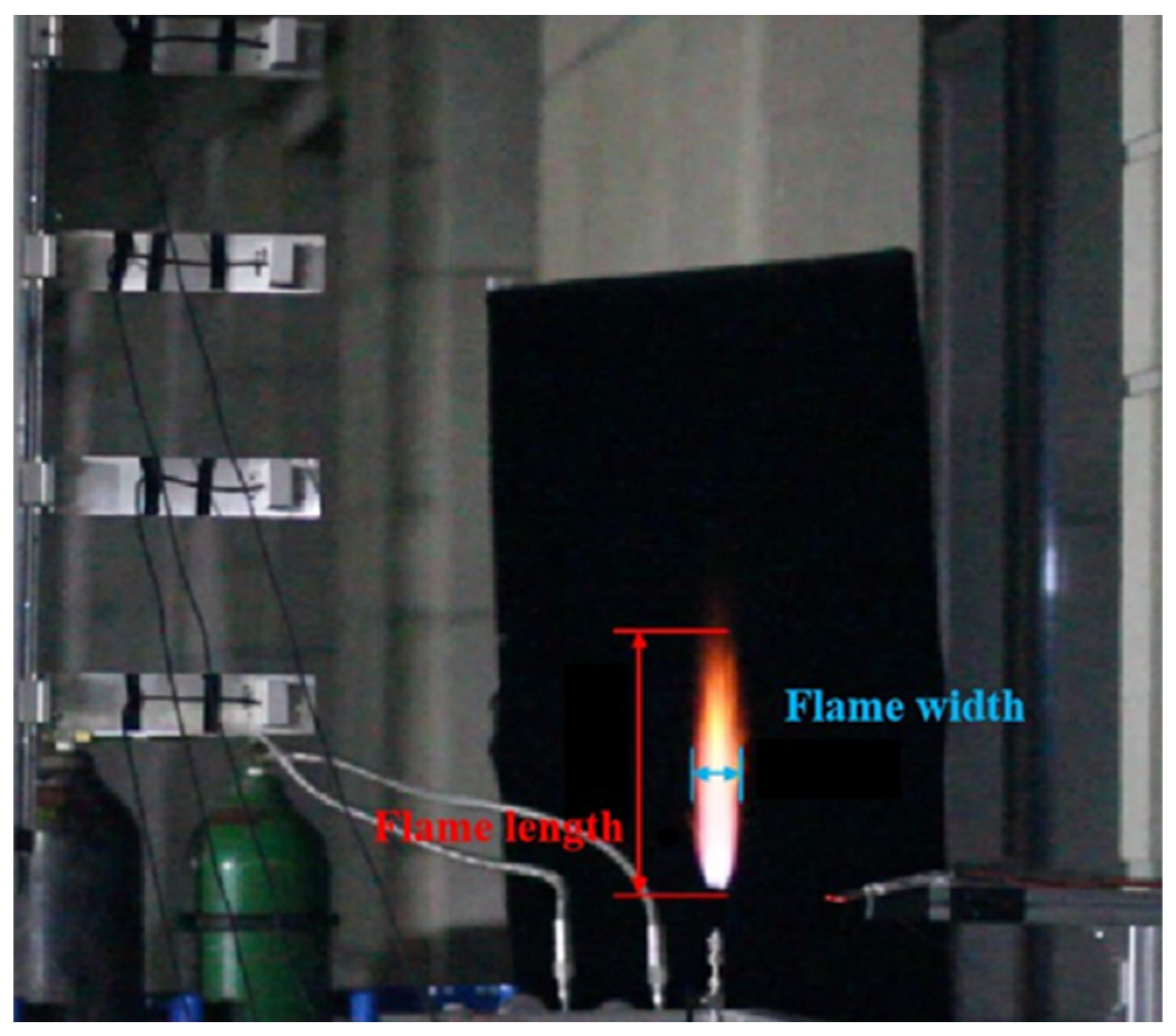
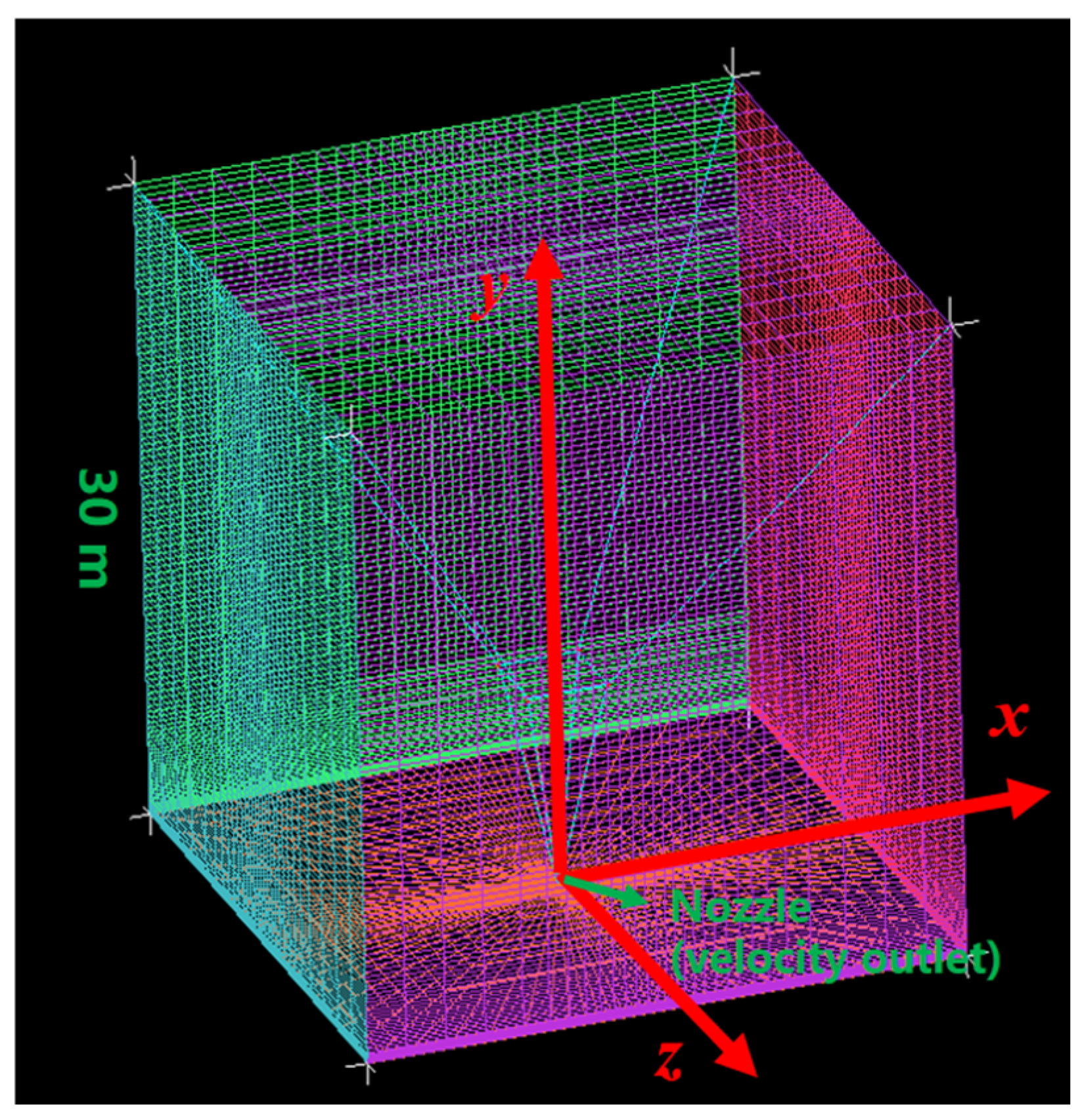
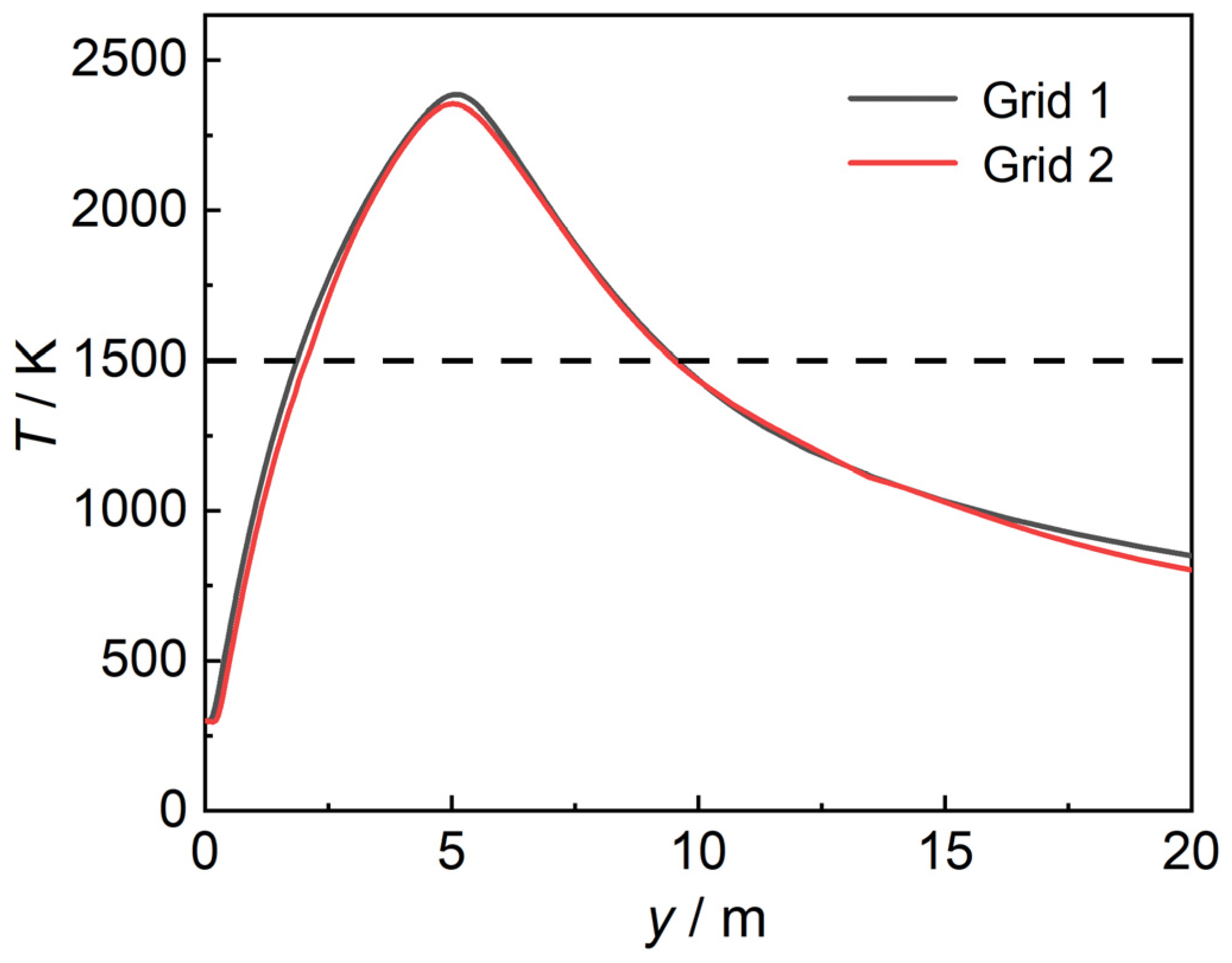

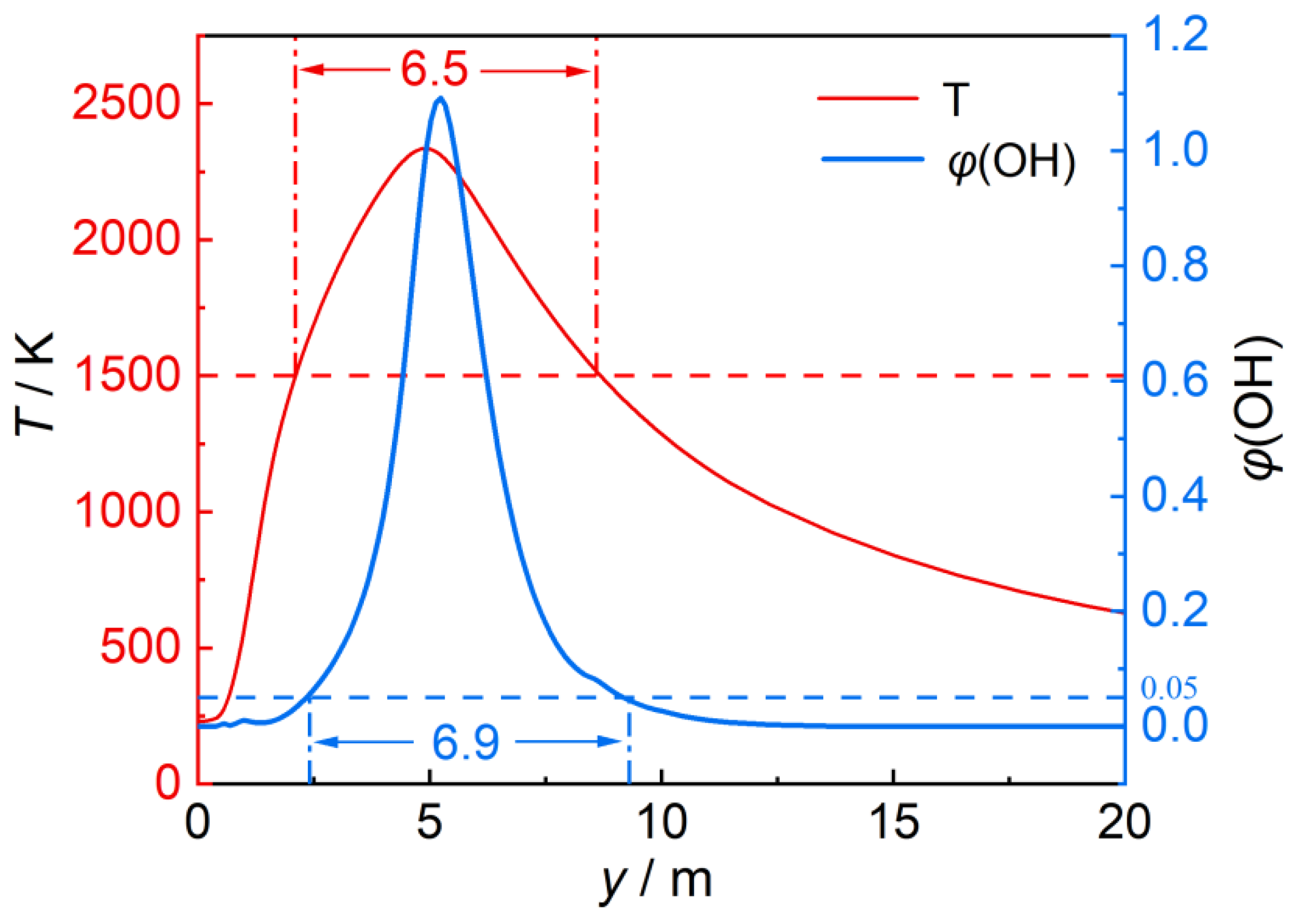

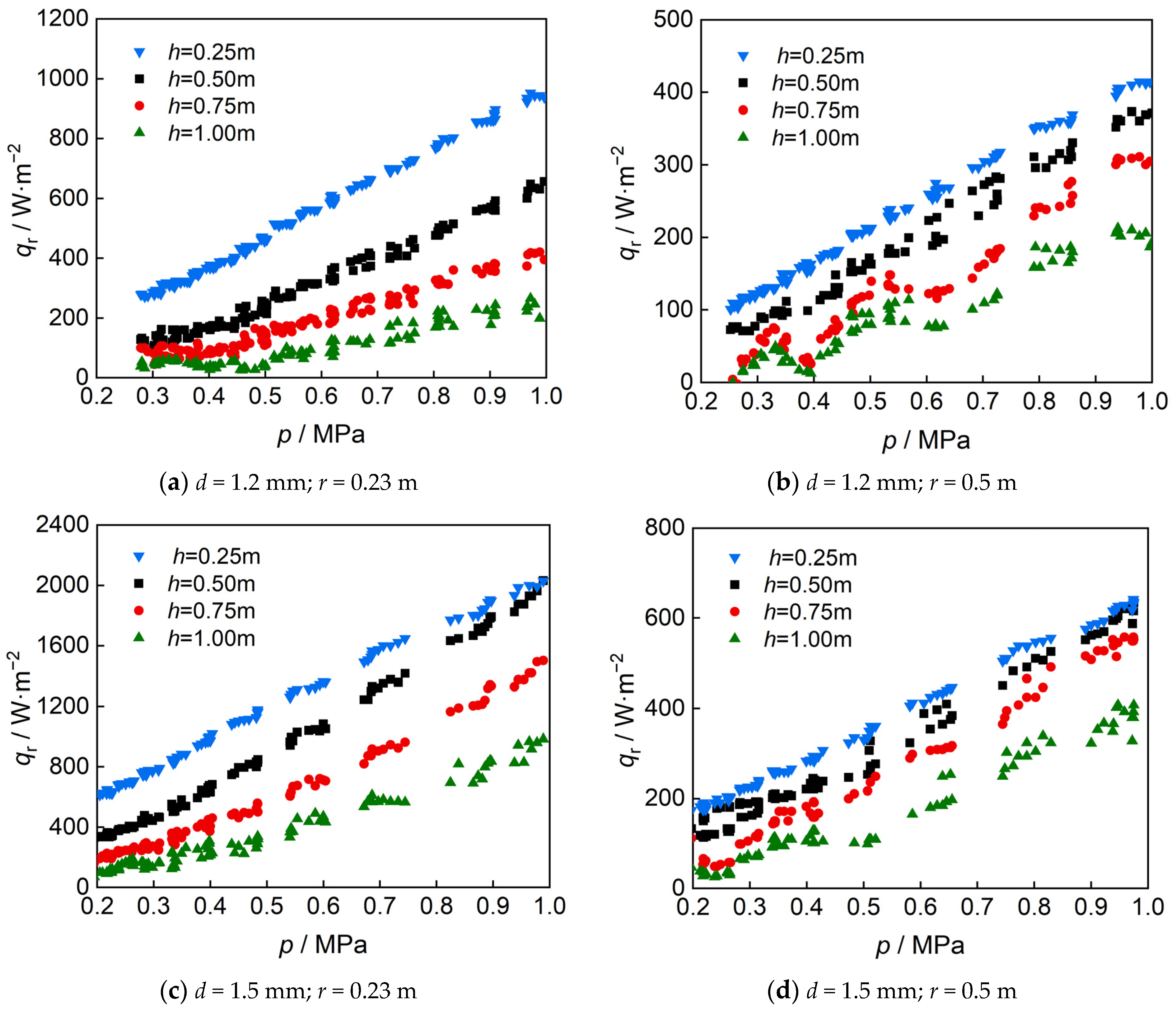
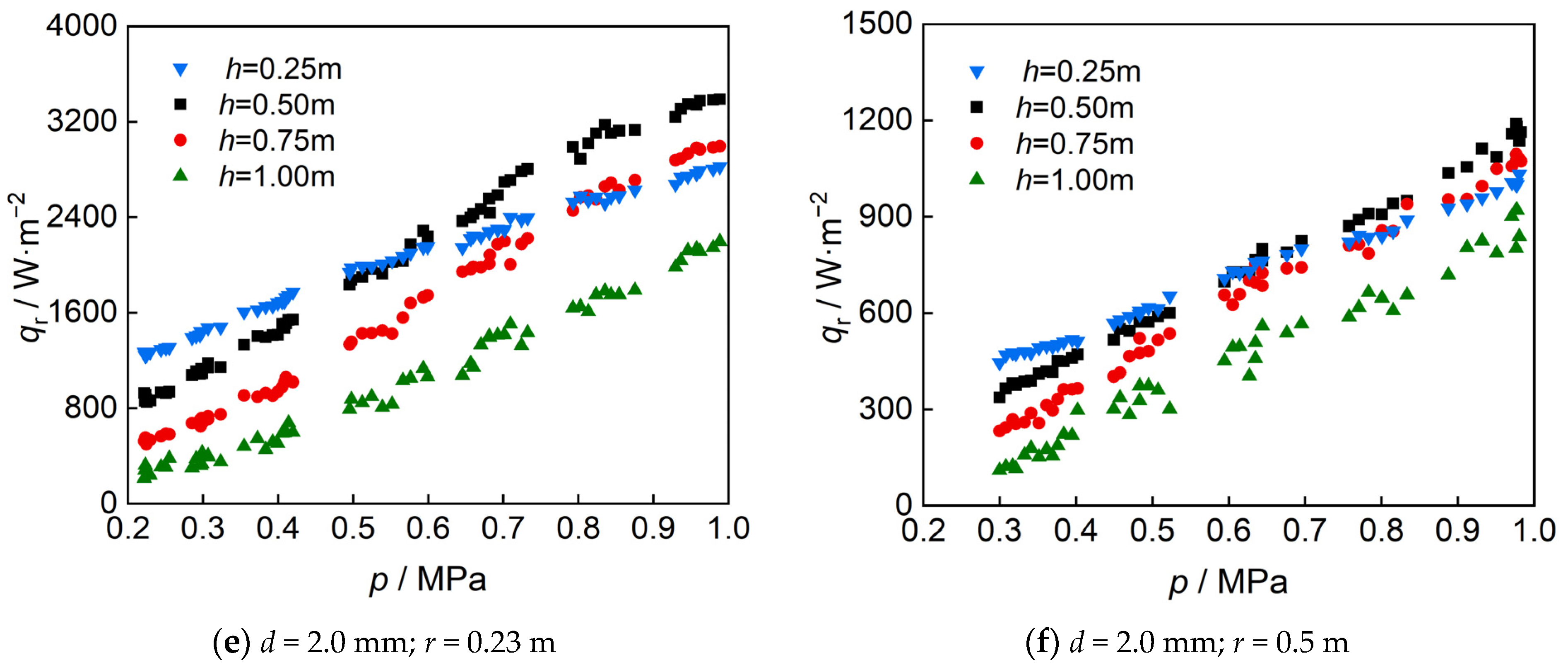
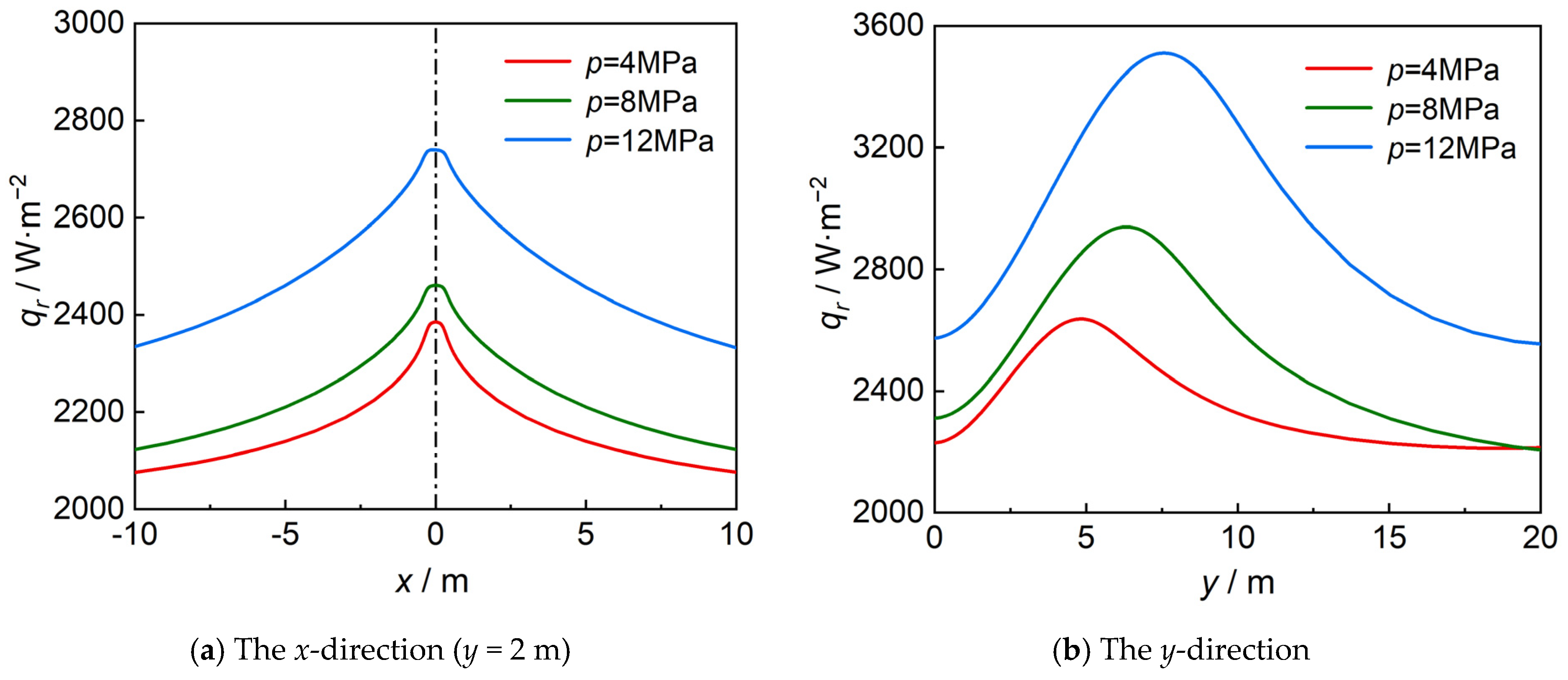
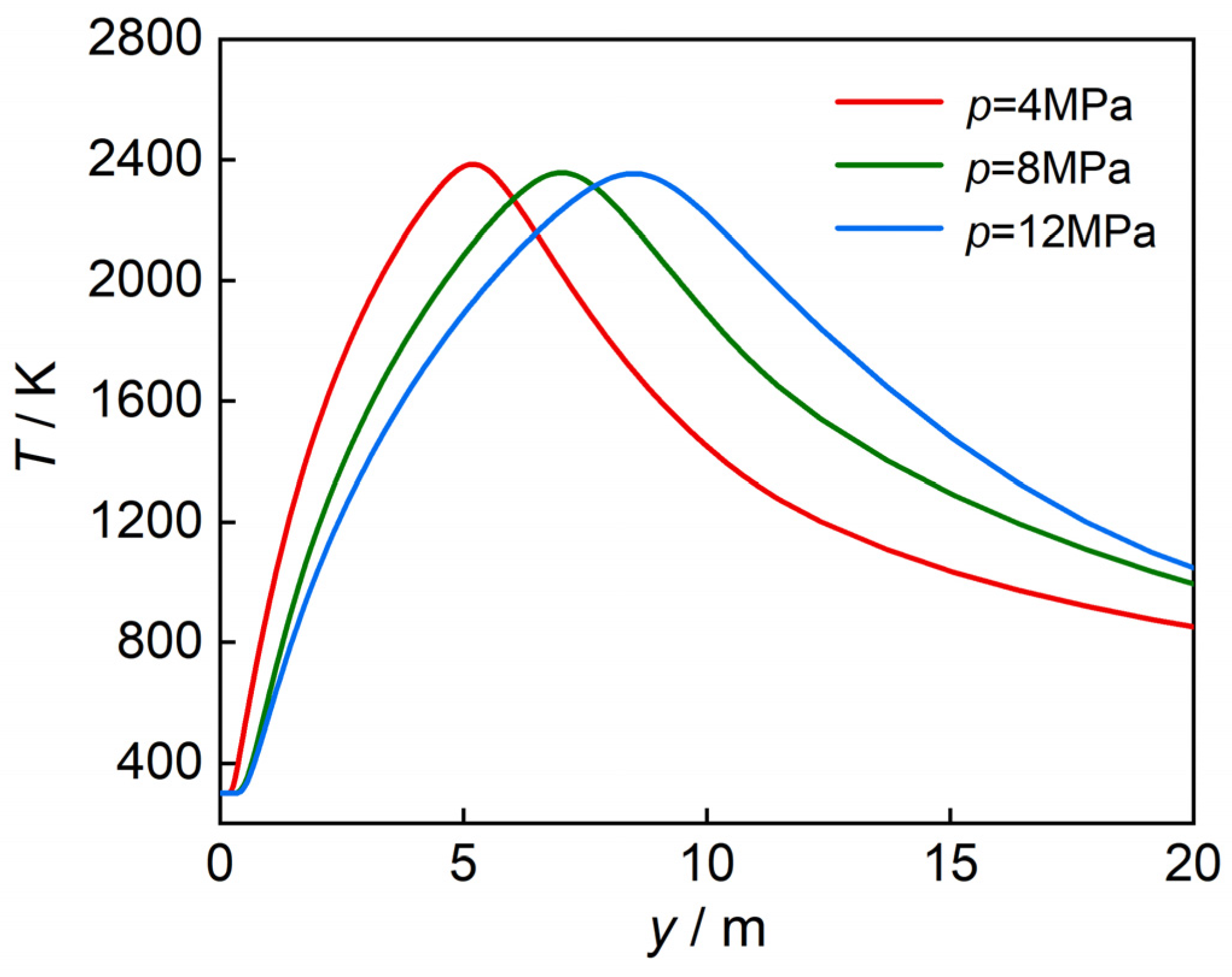
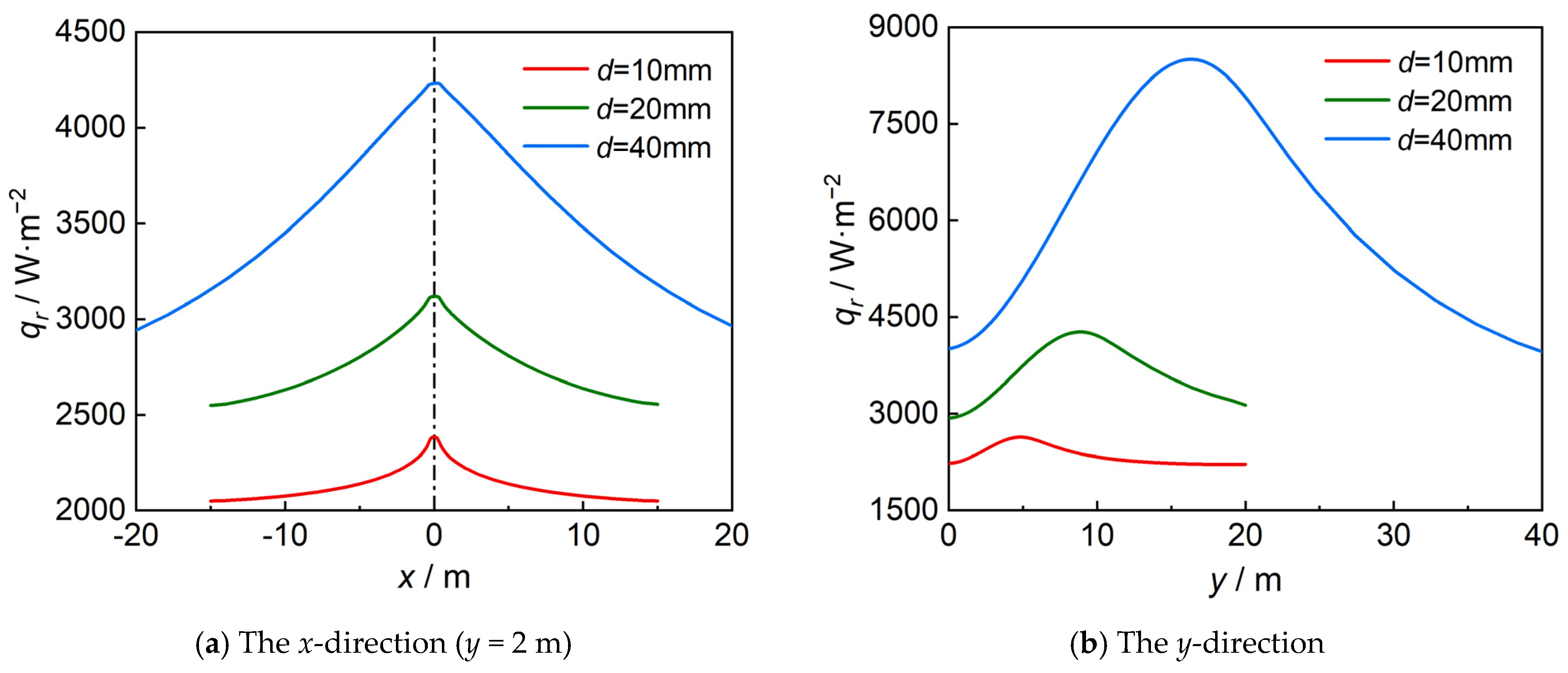
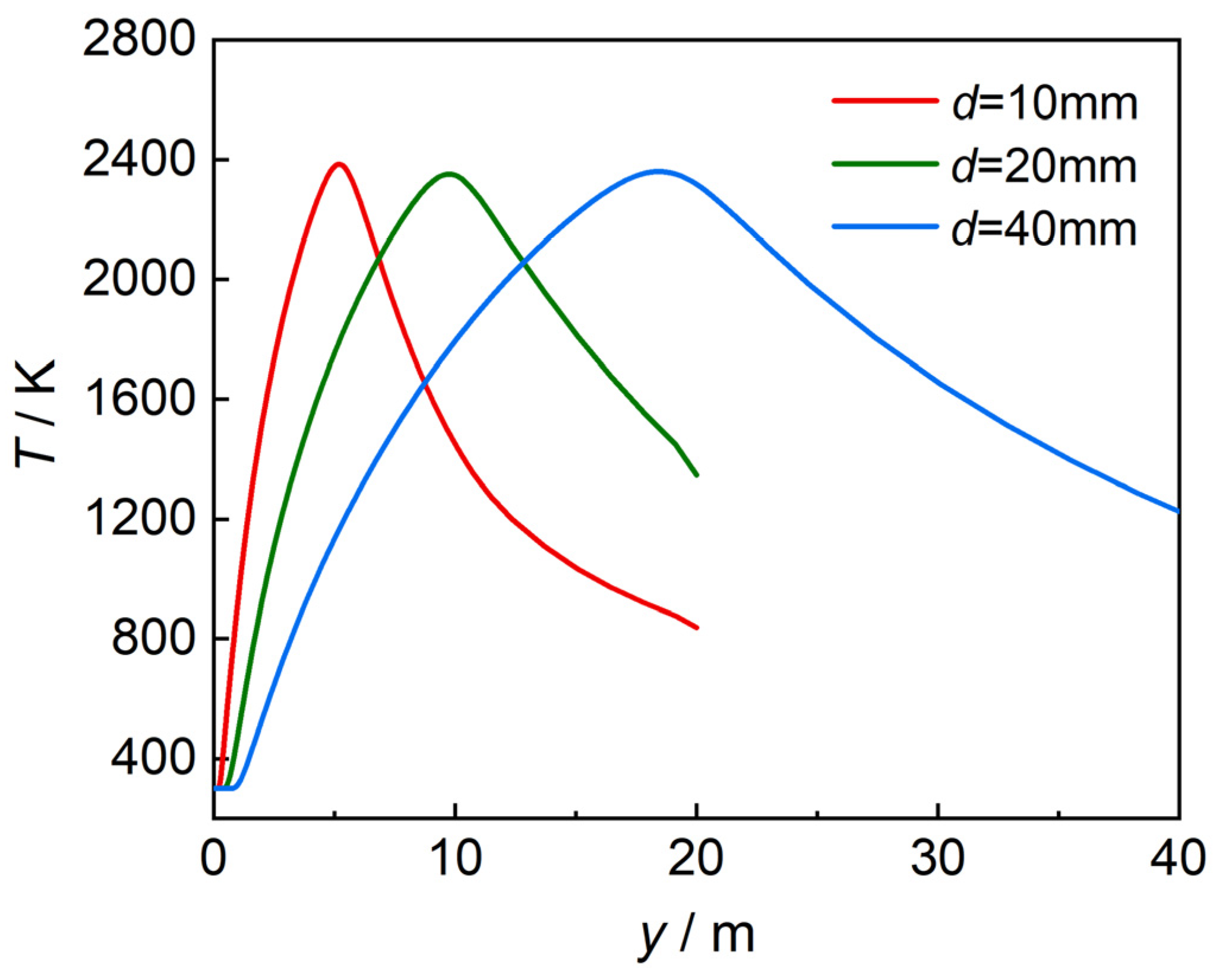
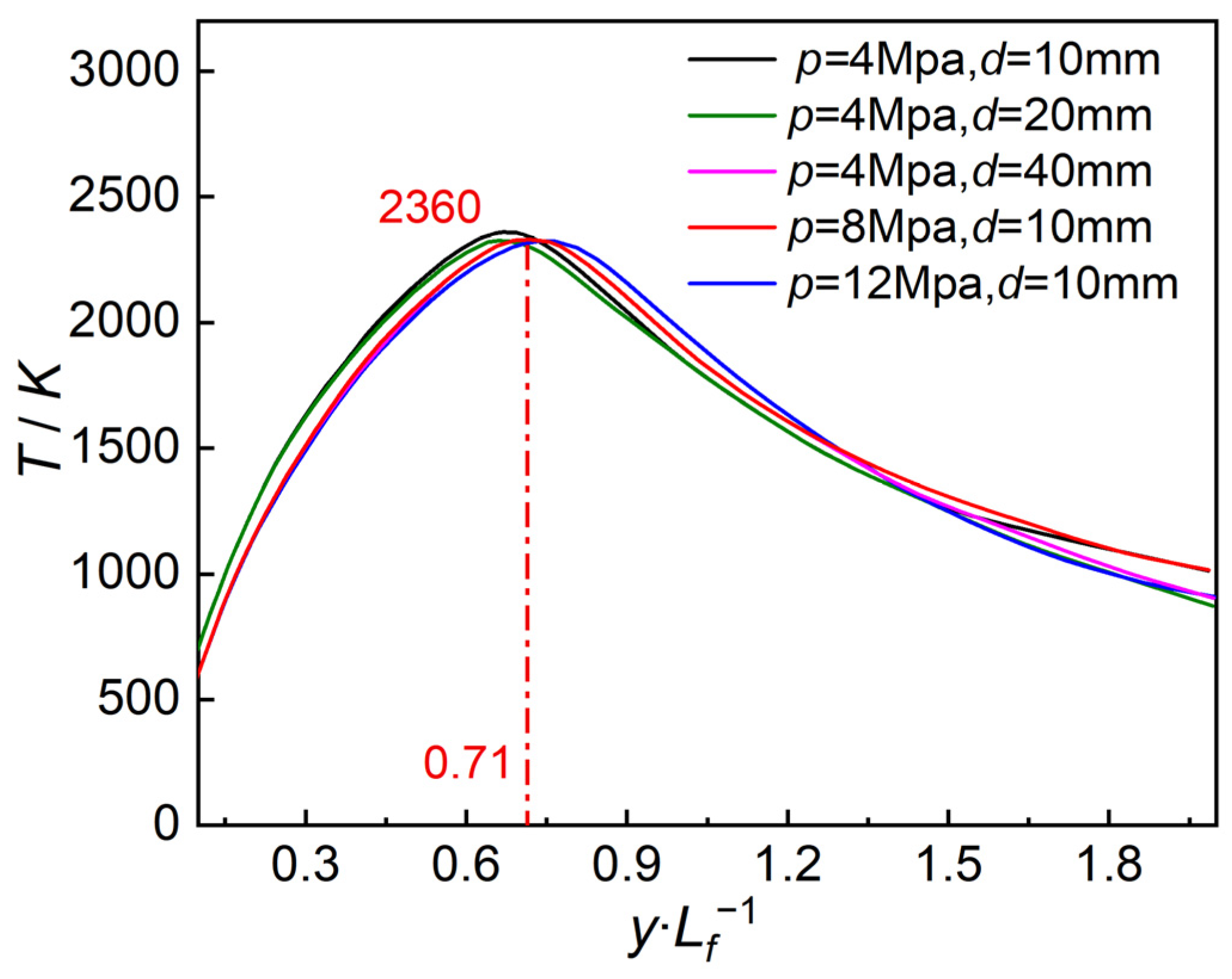

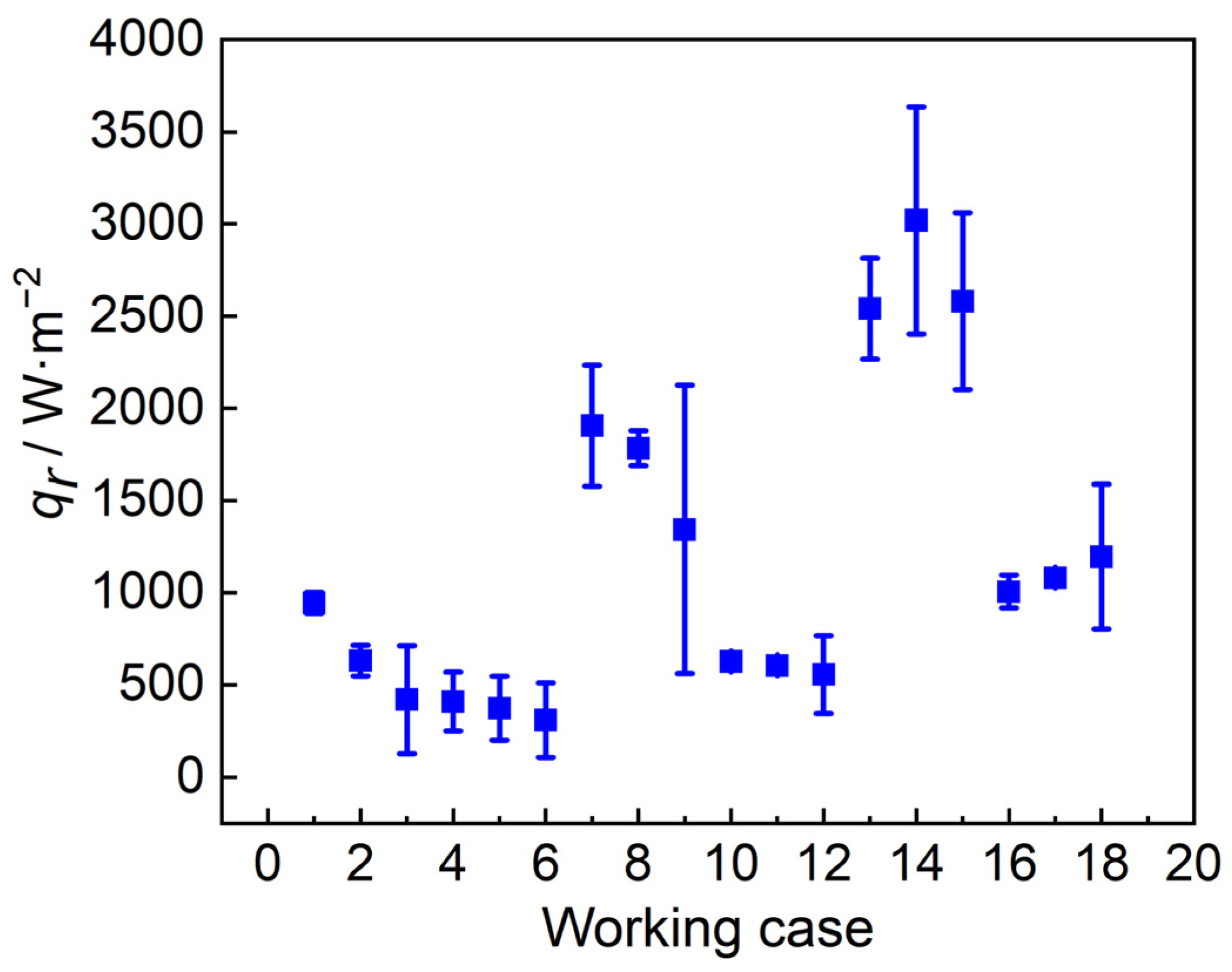

| Condition | Leakage Pressure/Mpa | Leakage Diameter/mm | Environmental Temperature/K | Description |
|---|---|---|---|---|
| 0 | 10.5 | 5 | 293 | Verification |
| 1 | 4 | 10 | 300 | Different leakage pressures |
| 2 | 8 | 10 | 300 | |
| 3 | 12 | 10 | 300 | |
| 4 | 4 | 20 | 300 | Different leakage diameters |
| 5 | 4 | 40 | 300 |
| Diameter/mm | Radial Distance/m | Height/m | Measurement/W·m−2 | Prediction/W·m−2 | Error/% |
|---|---|---|---|---|---|
| 1.2 | 0.23 | 0.25 | 944.2 | 1002.2 | 6.14 |
| 0.50 | 630.9 | 547.6 | 13.2 | ||
| 0.75 | 420.6 | 128.3 | 69.5 | ||
| 0.50 | 0.25 | 409.8 | 250.2 | 38.95 | |
| 0.50 | 373.3 | 200.7 | 46.24 | ||
| 0.75 | 309.0 | 107.2 | 65.31 | ||
| 1.5 | 0.23 | 0.25 | 1905.6 | 2233.7 | 17.22 |
| 0.50 | 1783.3 | 1878.4 | 5.33 | ||
| 0.75 | 1343.3 | 561.3 | 58.21 | ||
| 0.50 | 0.25 | 626.6 | 610.8 | 2.52 | |
| 0.50 | 605.2 | 574.4 | 5.09 | ||
| 0.75 | 555.8 | 344.7 | 37.98 | ||
| 2.0 | 0.23 | 0.25 | 2540.8 | 2815.4 | 10.81 |
| 0.50 | 3019.3 | 3635.2 | 20.40 | ||
| 0.75 | 2581.5 | 2102.1 | 18.57 | ||
| 0.50 | 0.25 | 1006.4 | 916.6 | 8.92 | |
| 0.50 | 1081.5 | 1059.3 | 2.05 | ||
| 0.75 | 1195.3 | 803.1 | 32.81 |
| Case | P/MPa | d/mm | R/m | qexp/W·m−2 | qmod,new/W·m−2 | qmod,old/W·m−2 |
|---|---|---|---|---|---|---|
| 1 | 1.83 | 6.35 | 2.9 | 1557 | 1729 | 1990 |
| 2 | 20.79 | 6.35 | 13.09 | 1557 | 1298 | 2045 |
| 3 | 51.81 | 4.23 | 13.27 | 1557 | 1470 | 1863 |
| 4 | 51.81 | 6.35 | 12.46 | 4732 | 3707 | 4181 |
| 5 | 51.81 | 6.35 | 21.58 | 1557 | 1303 | 1877 |
| 6 | 103.52 | 6.35 | 30.46 | 1557 | 1364 | 1653 |
Disclaimer/Publisher’s Note: The statements, opinions and data contained in all publications are solely those of the individual author(s) and contributor(s) and not of MDPI and/or the editor(s). MDPI and/or the editor(s) disclaim responsibility for any injury to people or property resulting from any ideas, methods, instructions or products referred to in the content. |
© 2024 by the authors. Licensee MDPI, Basel, Switzerland. This article is an open access article distributed under the terms and conditions of the Creative Commons Attribution (CC BY) license (https://creativecommons.org/licenses/by/4.0/).
Share and Cite
Zhang, H.; Cao, X.; Yuan, X.; Wu, F.; Wang, J.; Zhang, Y.; Li, Q.; Liu, H.; Huang, Z. Study on Thermal Radiation Characteristics and the Multi-Point Source Model of Hydrogen Jet Fire. Appl. Sci. 2024, 14, 7098. https://doi.org/10.3390/app14167098
Zhang H, Cao X, Yuan X, Wu F, Wang J, Zhang Y, Li Q, Liu H, Huang Z. Study on Thermal Radiation Characteristics and the Multi-Point Source Model of Hydrogen Jet Fire. Applied Sciences. 2024; 14(16):7098. https://doi.org/10.3390/app14167098
Chicago/Turabian StyleZhang, Haiyang, Xun Cao, Xuhao Yuan, Fengrong Wu, Jing Wang, Yankang Zhang, Qianqian Li, Hu Liu, and Zuohua Huang. 2024. "Study on Thermal Radiation Characteristics and the Multi-Point Source Model of Hydrogen Jet Fire" Applied Sciences 14, no. 16: 7098. https://doi.org/10.3390/app14167098
APA StyleZhang, H., Cao, X., Yuan, X., Wu, F., Wang, J., Zhang, Y., Li, Q., Liu, H., & Huang, Z. (2024). Study on Thermal Radiation Characteristics and the Multi-Point Source Model of Hydrogen Jet Fire. Applied Sciences, 14(16), 7098. https://doi.org/10.3390/app14167098






